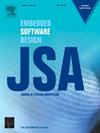基于深度强化学习的6G网络可扩展VR视频分层与功率分配联合优化
IF 3.7
2区 计算机科学
Q1 COMPUTER SCIENCE, HARDWARE & ARCHITECTURE
引用次数: 0
摘要
随着虚拟现实(VR)技术的发展和应用,对网络带宽和计算能力的需求越来越大。针对VR视频传输中带宽要求高、时延要求低、计算量大的问题,提出了一种基于深度强化学习(Deep Reinforcement Learning, DRL)的分层和功率分配联合优化方法。该方法以6G网络下可扩展VR视频的传输为重点,利用DRL实现云-边缘协同传输框架,将基于tile的可扩展VR视频主动缓存到MEC节点,并采用异步优势Actor-Critic (A3C)算法共同优化双连接链路资源、边缘计算资源和用户终端计算资源。通过仿真实验,验证了所提算法的有效性。结果表明,与基线算法和现有方法相比,本文提出的A3C算法有效地提高了VR用户的平均体验质量(QoE),并在各种sub-6G和毫米波链路容量下保持低延迟。此外,随着移动边缘计算(MEC)计算能力和用户设备(UE)计算能力的提高,该方法可以进一步提高QoE并降低延迟。本文章由计算机程序翻译,如有差异,请以英文原文为准。
Joint optimization of layering and power allocation for scalable VR video in 6G networks based on Deep Reinforcement Learning
With the advancement and application of virtual reality (VR) technology, there is a growing demand for network bandwidth and computational capabilities. To address the challenges of high bandwidth requirements, low latency demands, and intensive computational tasks in VR video transmission, this paper proposes a joint optimization method for layering and power allocation based on Deep Reinforcement Learning (DRL). The method focuses on the transmission of scalable VR videos in 6G networks, utilizing DRL to achieve a cloud-edge-end collaborative transmission framework, where Tile-based scalable VR video is proactively cached to the MEC nodes, and Asynchronous Advantage Actor-Critic (A3C) algorithm is adopted to jointly optimize dual-connected link resources, edge computing resources, and user terminal computing resources. Through simulation experiments, the effectiveness of the proposed algorithms was validated. The results show that compared to baseline algorithms and state-of-the-art methods, the proposed A3C algorithm effectively improves the average quality of experience (QoE) for VR users and maintains low latency under various sub-6G and millimeter wave link capacities. Furthermore, with increased Mobile Edge Computing (MEC) computing power and User Equipment (UE) computing capabilities, the proposed method can further improve QoE and reduce latency.
求助全文
通过发布文献求助,成功后即可免费获取论文全文。
去求助
来源期刊

Journal of Systems Architecture
工程技术-计算机:硬件
CiteScore
8.70
自引率
15.60%
发文量
226
审稿时长
46 days
期刊介绍:
The Journal of Systems Architecture: Embedded Software Design (JSA) is a journal covering all design and architectural aspects related to embedded systems and software. It ranges from the microarchitecture level via the system software level up to the application-specific architecture level. Aspects such as real-time systems, operating systems, FPGA programming, programming languages, communications (limited to analysis and the software stack), mobile systems, parallel and distributed architectures as well as additional subjects in the computer and system architecture area will fall within the scope of this journal. Technology will not be a main focus, but its use and relevance to particular designs will be. Case studies are welcome but must contribute more than just a design for a particular piece of software.
Design automation of such systems including methodologies, techniques and tools for their design as well as novel designs of software components fall within the scope of this journal. Novel applications that use embedded systems are also central in this journal. While hardware is not a part of this journal hardware/software co-design methods that consider interplay between software and hardware components with and emphasis on software are also relevant here.
 求助内容:
求助内容: 应助结果提醒方式:
应助结果提醒方式:


